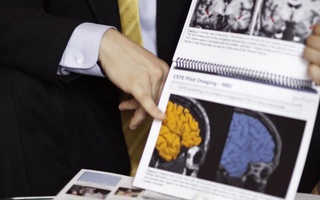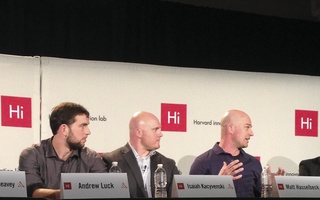“We want to tell coaches that the brain is far more fragile than we [ever] knew,” Nowinski says. “Every hit to the head counts ... players need to understand that there are serious long-term ramifications to abusing your brain, and that there’s no such thing as a ‘tough’ brain. They need to be more careful at what they do and need to become comfortable with not only sitting out with a concussion but also not using their head as a weapon.”
Nowinski says that as awareness has spread, it’s gotten easier to encourage families of deceased players, as well as current athletes, to promise to donate their brains for research.
After Kacyvenski, four NFL players, including three former pro-bowlers—Ravens center Matt Birk ’98, Seahawks linebacker Lofa Tatupu, and Cardinals receiver Sean Morey—pledged in 2009 to donate their brains and spinal cord tissue to the CSTE upon death, so that researchers could learn more about the effects of trauma on those organs.
“There’s less convincing now because people have heard of the work,” Nowinski says. “In our first two years at BU, 20 brains were donated, and last year [we received] 50 brains.”
But despite the success, there’s a difficult part to Nowinski’s job as well.
“You’re calling the family of a famous athlete who had just died in a horrible way,” Nowinski explains. “That first call to families is something that I still will never be comfortable with ... but people understand and want to see something good come out of a tragedy.”
In the past few years, thanks in large part to Nowinski’s research, both the public and athletes have become more aware of the dangers posed by concussions.
In 2009, the NFL instituted new rules changes that enforced stricter restrictions on allowing players to return to games or practices after head injuries. Now, any player who shows certain signs or symptoms of head injury—dizziness, headaches, and memory gaps—is not allowed to return on the same day.
“There’s independent doctors on sidelines now for the players,” Kacyvenski says. “You have medical coverage that says this player is hurt with a serious concussion, and doesn’t put manhood in question ... there’s a better protocol in place for diagnosing concussions. People understand better. You can’t just kind of play it off anymore. Awareness has skyrocketed.”
The new rules have made strides towards solving what remains a major problem. Nearly a fifth of NFL players surveyed by The Associated Press in November 2009 replied that they had hidden or played down the effects of a concussion.
“The people that make it [to the NFL] are wired to ignore the pain, over and over again,” Kacyvenski says. “You can’t treat a concussion like a broken arm and leg. It’s very difficult to prove...Chris has made this not a football issue; it’s now a public health issue. That’s a key distinction…[his impact] really is kind of amazing.”
In 2010, the NFL expanded its rules to prevent defenseless players from taking shots above their shoulders, with significant fines for any player who makes head-to-head contact with an opponent. Even more stringent return-to-play guidelines were instituted for players who had suffered concussions, and each team was required to consult with an independent neurologist in every case of a head injury.
Murphy, who has coached college football for 24 years and is currently Vice President of the American Football Coaches Association, could not be more impressed with the impact his former player is having.
“I follow his work very, very closely, and first and foremost I’m very proud of Chris,” Murphy says. “I don’t think there’s anyone else in the country who’s helped advance the knowledge of athletic head trauma as much as he has. I think a lot of what you’re seeing in changes in rules in protocol dealing with head trauma is a result of the work that he’s done.”
CHRIS HARVARD’ S IMPACT
Read more in Sports
TEAM OF THE YEAR RUNNER-UP: Crimson Dominates Nation’s BestRecommended Articles
-
Ivy League Leads Trend in Concussion PreventionThe winds of change howling through the world of sports safety have become impossible to ignore. Traditional football has nearly been toppled by the gusts, and the winds’ next victim, hockey, lies just around the corner. Adding to the drafts is none other than our little Ivy League. The breezes began back in 2009, when the NFL was called out by Congress for not adequately protecting its players from the dangers of concussions and other head injuries.
-
Who You Should Root for in the NFL PlayoffsHome team knocked out of the playoffs? Still reeling from Fitzpatrick’s fourth place AFC East finish? The Back Page has ...
-
 Concussed: Down and Out
Concussed: Down and Out -
Panelists Discuss Head Trauma ResearchThree panelists described current medical research and long-term goals to reform care and policy on athletic head trauma and concussions during a biannual symposium of the Harvard Society for Mind, Brain, and Behavior in Science Center C on Friday afternoon.
-
Murphy Era of Harvard Football Turns 20Twenty years into his Harvard tenure, football coach Tim Murphy reflects on the most memorable games, seasons, and players of his career with the Crimson.
-
 Professional Athletes Discuss Intersection of Sports, Tech at I-Lab
Professional Athletes Discuss Intersection of Sports, Tech at I-Lab













